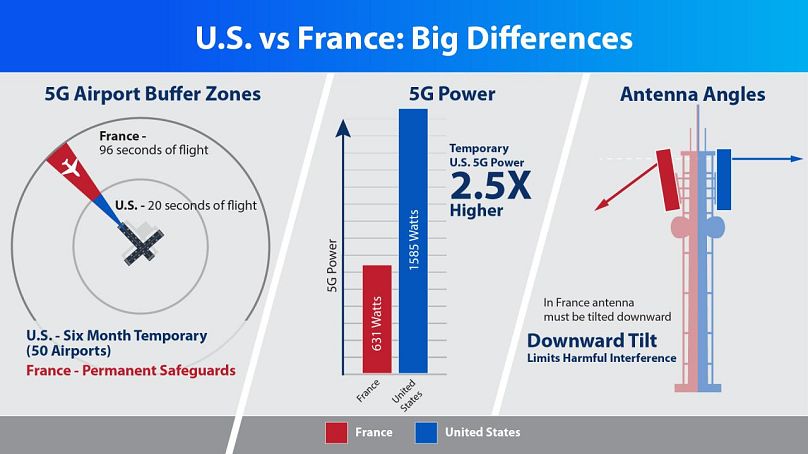US authorities said 5G signal could affect the altimeters in some planes, reducing their ability to slow down after landing in certain conditions.
Some Boeing 787 passenger jets should take extra care when landing in wet or snowy conditions at airports near 5G towers, American air safety officials have said.
Interference from 5G signals could affect the planes' altimeters, leading to delays deploying the spoilers and thrust reversers that slow aircraft down after landing, the Federal Aviation Authority (FAA) said.
"The presence of 5G C-Band interference can result in degraded deceleration performance, increased landing distance, and runway excursion," the authority said in a statement released on Friday.
In simple terms, this means that interference could lead, in the worst case, to a plane running off the end of the runway.
In a notification to airlines, the FAA said that Boeing 787s operated by over 80 international airlines including Air France, British Airways, KLM, LOT, and holiday operator TUI could be affected by interference when landing at airports in the United States.
The FAA's guidance comes ahead of the launch of the dedicated C-band 5G service by US mobile operators on Wednesday.
On Sunday, the regulator said 45 per cent of the US domestic airline fleet was cleared to land in poor weather conditions at 48 American airports where C-Band 5G will be switched on on January 19.
The planes cleared to fly include the Boeing 737, 747, 757 and 767, and the Airbus A319, A320, A321, A330 and A350.
What interference?
The FAA's advice relates to a specific set of circumstances that could occur in bad weather at airports in areas with C-Band 5G service.
5G signals operate on a portion of the radio frequency spectrum relatively similar to that used by the radio altimeters in some aircraft. Pilots rely on altimeters to land when visibility is low.
According to aircraft maker Boeing, data from the devices is used to switch 787 aircraft from air to ground mode. Without that switch, key functions like automatic thrust reverser deployment might not happen, meaning the plane would need more room to land safely.
"Aircraft with untested altimeters or that need retrofitting or replacement will be unable to perform low-visibility landings where 5G is deployed," the agency said in a statement.
The order regarding Boeing 787s covers 137 planes in the US and 1,010 worldwide. The wide-bodied 787 is commonly used for long-haul flights.
In December last year, Europe's air safety regulator the EASA responded to the FAA's concerns over 5G interference, concluding that "at this stage, no risk of unsafe interference has been identified in Europe".
Why is 5G different?
The issue the FAA is talking about relates to the part of the wireless frequency spectrum given over to 5G, particularly in the US.
Most countries around the world have dedicated a portion of the C-Band radio frequency to 5G. In Europe, this falls in the 3.3-3.8 GHz segment of the wireless spectrum, but in the US, the 5G network due to be switched on this week will operate at 3.7-3.9 GHz.
The radio altimeters in aircraft operate at a frequency of 4.2-4.4 GHz, bringing the 5G signal uncomfortably close, as far as the air safety regulator is concerned.
European regulators have also voiced worries about 5G interference, leading some countries to act.
France's aviation safety authority, the DGAC, issued a notice in February last year stating that altimeter errors could have a "significant adverse impact on flight safety" and recommending that 5G-enabled devices should not be used inflight.
The FAA has also taken a leaf out of France's book, putting buffer zones in place around 50 major airports where mobile network operators will have to turn off 5G towers or work to limit their potential to interfere with aircraft.
This buffer zone will be wide enough to cover the final 20 seconds of flight before landing, the FAA said. That compares to the 96-second buffer zone in force in France, where 5G antennas are also angled downwards in order to reduce the risk of interference.












